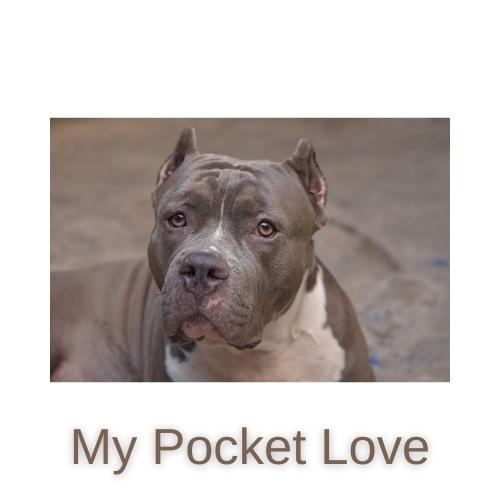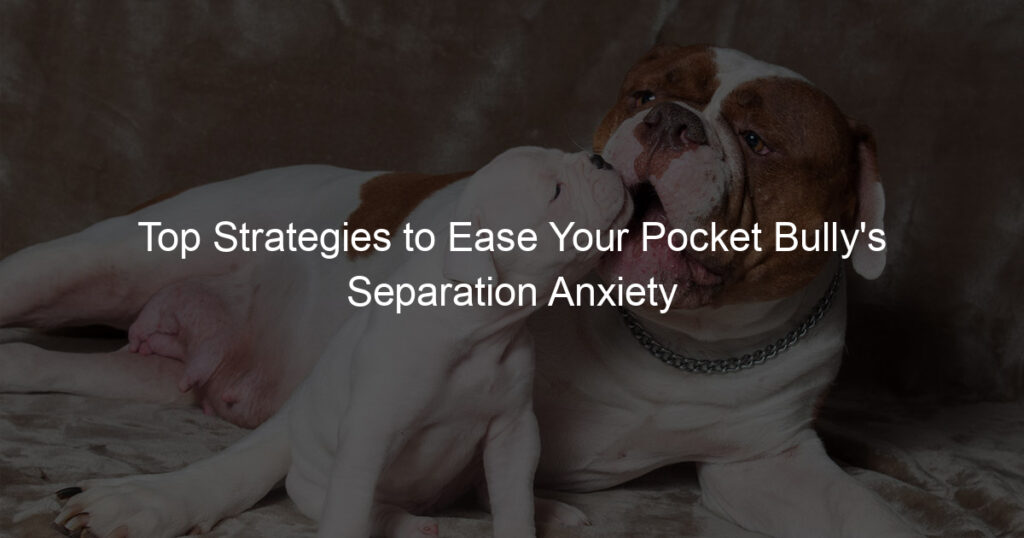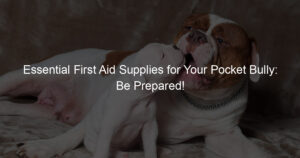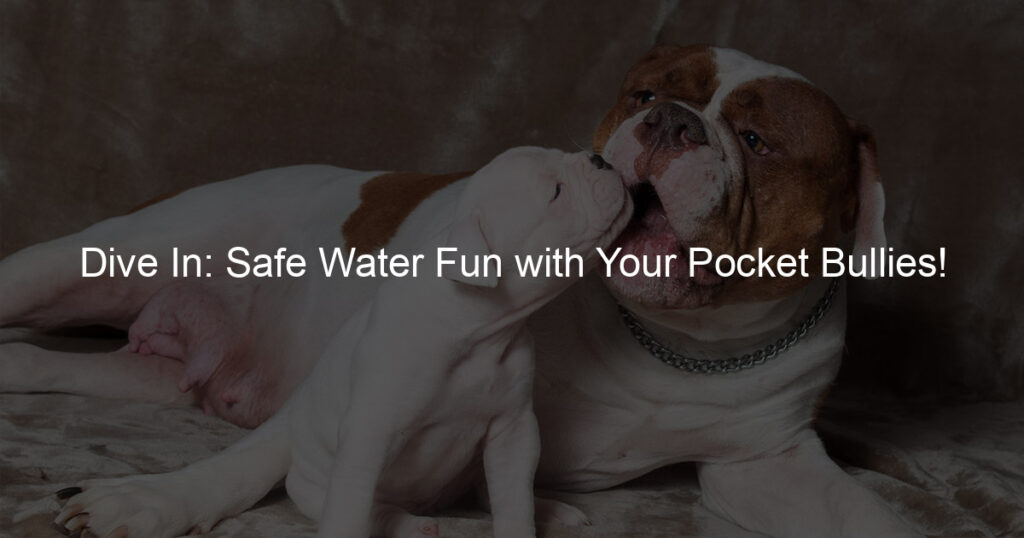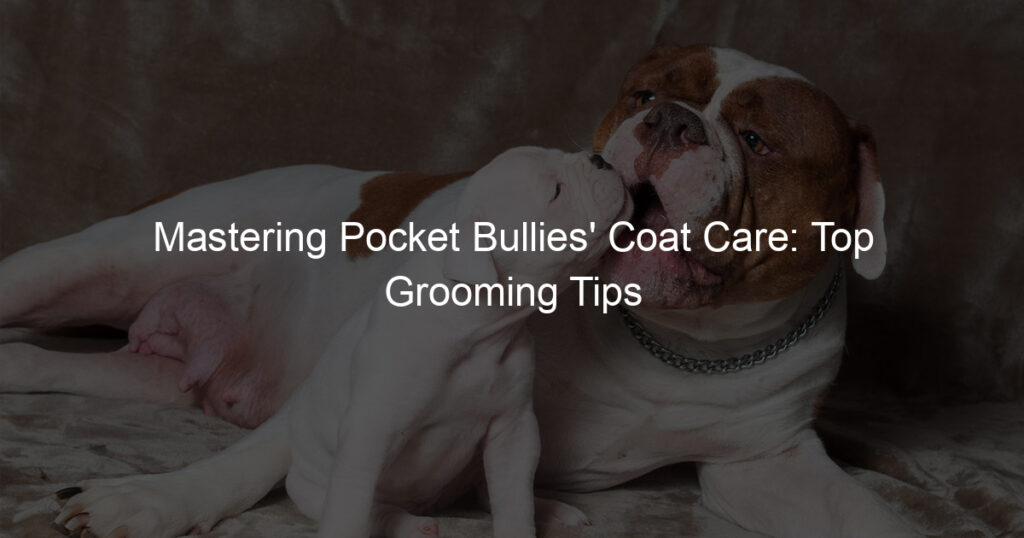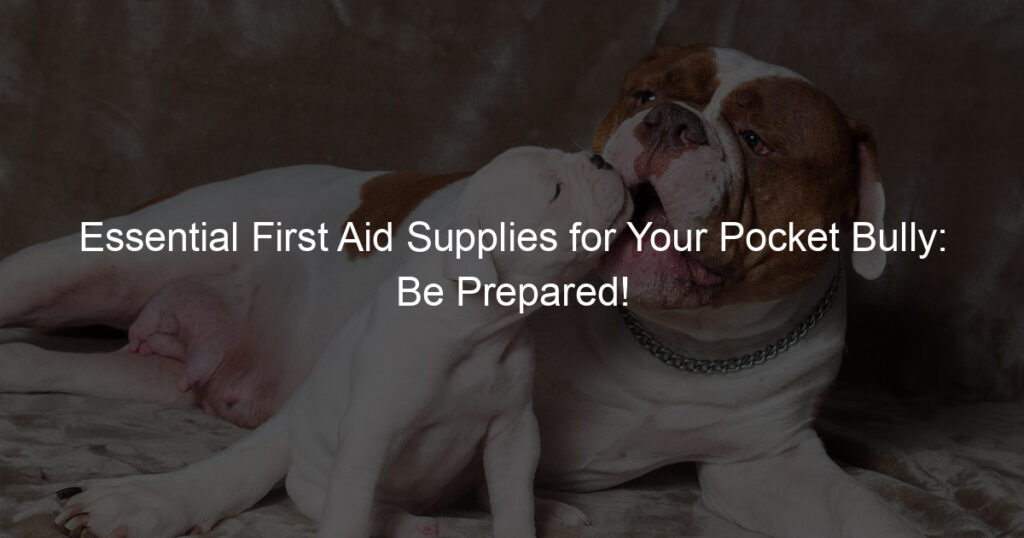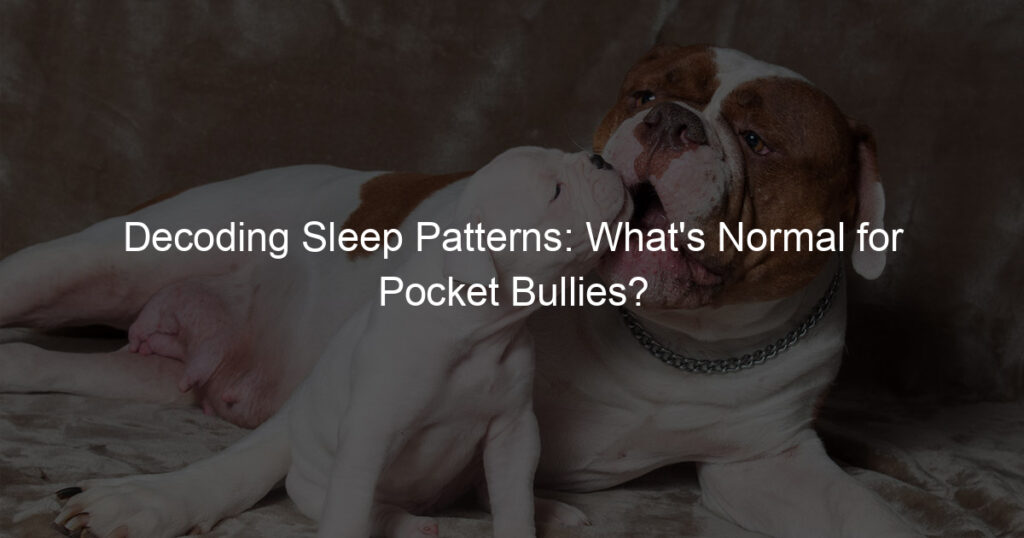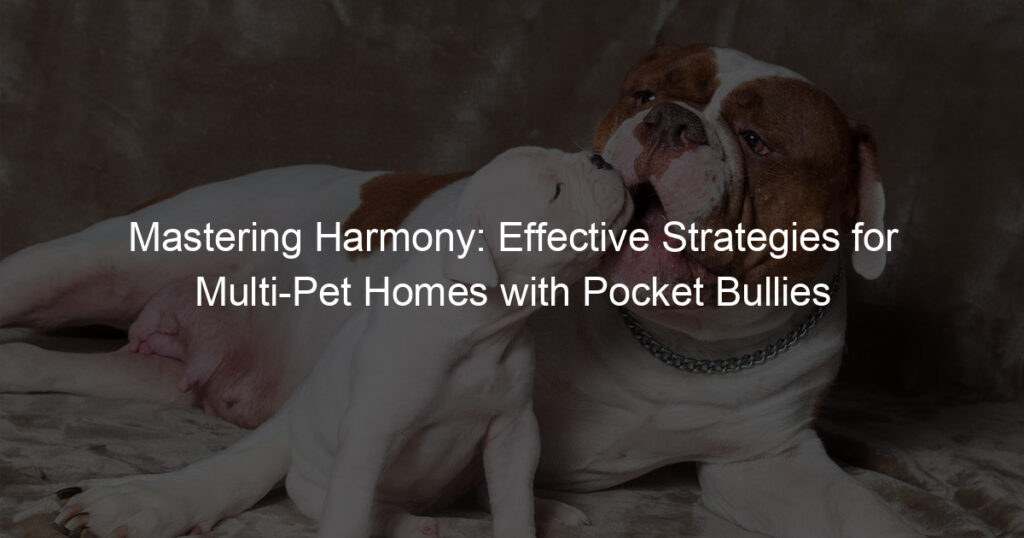
Understanding Separation Anxiety in Pocket Bullies
Separation anxiety is a common issue among many breeds of dogs, and Pocket Bullies are no exception. This condition can cause a great deal of stress for both the dog and its owner. To help you better understand and manage this issue, we will discuss what separation anxiety is, its common signs and symptoms, and what causes it in Pocket Bullies.
- Definition of Separation Anxiety
- Common Signs and Symptoms
- Excessive barking or howling when left alone
- Destructive behavior, such as chewing furniture or scratching at doors
- Attempts to escape from the home
- Pacing or restlessness
- Excessive drooling or panting
- Causes of Separation Anxiety in Pocket Bullies
- Changes in routine or schedule
- Moving to a new home
- Loss of a family member or another pet
- Spending too much time alone
Separation anxiety in dogs, including Pocket Bullies, is a distressing condition that occurs when a dog becomes overly attached to its owner and becomes anxious when left alone. This anxiety can manifest in a variety of ways, including destructive behavior, excessive barking, and even attempts to escape from the home.
There are several signs that your Pocket Bully may be suffering from separation anxiety. These include:
It’s important to note that these behaviors can also be signs of other issues, so it’s crucial to consult with a veterinarian if you notice any of these symptoms in your Pocket Bully.
There is no single cause of separation anxiety in dogs. It can be triggered by a variety of factors, including:
Understanding the causes of separation anxiety can help you take steps to prevent or manage this condition in your Pocket Bully.
In conclusion, separation anxiety in Pocket Bullies is a serious condition that requires understanding and proper management. By recognizing the signs and understanding the causes, you can help your Pocket Bully live a happier, less anxious life.
Pocket Bullies Anxiety Solutions
When it comes to managing anxiety in Pocket Bullies, there are several effective solutions that can help. One of the most effective methods is behavioral training. This involves teaching your Pocket Bully new responses to situations that currently cause them anxiety. Let’s delve into the key behavioral training techniques that can help alleviate anxiety in your Pocket Bully.
Behavioral Training
Behavioral training is a powerful tool in managing anxiety in Pocket Bullies. It involves teaching your dog new responses to situations that currently cause them anxiety. This type of training can be broken down into three main techniques:
- Counter-Conditioning
- Desensitization
- Positive Reinforcement
Counter-conditioning is a process that changes an animal’s fearful, aggressive or anxious reaction to a pleasant, relaxed one instead. It’s like turning the tables on the anxiety, teaching your Pocket Bully to associate positive experiences with situations that previously caused anxiety.
Desensitization involves gradually exposing your Pocket Bully to the source of their anxiety in a controlled way. Over time, this can help them become less sensitive to it. For example, if your Pocket Bully is anxious about being left alone, you might start by leaving them alone for just a few minutes at a time, gradually increasing the duration as they become more comfortable.
Positive reinforcement involves rewarding your Pocket Bully for displaying positive behavior. This could be as simple as giving them a treat when they remain calm in a situation that would normally cause them anxiety. Over time, they will learn to associate these situations with positive experiences, reducing their anxiety.
These behavioral training techniques can be highly effective in managing anxiety in Pocket Bullies. However, it’s important to remember that every dog is unique, and what works for one might not work for another. It may take some time and patience to find the right approach for your Pocket Bully, but the results can be well worth it.
Professional Help
When dealing with separation anxiety in Pocket Bullies, professional help can be an invaluable resource. There are two types of professionals who can assist: Animal Behaviorists and Veterinary Behaviorists.
- Animal Behaviorists
- Veterinary Behaviorists
An Animal Behaviorist is a professional who specializes in the behavior of animals. They use scientific methods to study and understand why animals behave the way they do. They can help you understand your Pocket Bully’s anxiety and provide strategies to manage it. For example, they might suggest changes in your dog’s environment or routine to reduce stress. They can also teach you techniques to help your dog feel more secure when you’re not around.
A Veterinary Behaviorist is a vet who has additional training in animal behavior. They can diagnose and treat behavior problems in animals, including separation anxiety in dogs. They might suggest medication to help your Pocket Bully cope with anxiety, in addition to behavior modification techniques. They can also rule out any medical conditions that could be causing your dog’s anxiety.
Remember, every Pocket Bully is unique. What works for one dog might not work for another. It’s important to work with a professional who can provide a personalized plan for your dog. With patience, consistency, and professional guidance, you can help your Pocket Bully overcome separation anxiety.
Alleviating Anxiety in Pocket Bullies
When it comes to alleviating anxiety in pocket bullies, environmental changes can play a significant role. By making a few simple adjustments, you can create an environment that helps your pocket bully feel safe and secure. Here are a couple of strategies you can try:
Environmental Changes
- Creating a Safe Space
- Providing Mental Stimulation
Just like humans, dogs also need a safe and comfortable space where they can relax. This could be a designated corner in your living room, a dog bed, or a crate. The key is to make this space as comfortable as possible. You can add soft blankets, toys, and even an item of your clothing to provide a sense of familiarity and comfort. This safe space will serve as a sanctuary for your pocket bully, especially during times of stress or anxiety.
Mental stimulation is crucial for dogs, especially for breeds like pocket bullies that are known for their intelligence and energy. Boredom can often lead to anxiety in dogs. Therefore, it’s essential to keep your pocket bully mentally stimulated. This can be achieved through puzzle toys, training sessions, or interactive games. Remember, a mentally stimulated dog is a happy dog!
By implementing these environmental changes, you can significantly alleviate anxiety in your pocket bully. Remember, every dog is unique, so it might take some time to figure out what works best for your furry friend. The key is to be patient and consistent.
Dietary Adjustments
One of the most effective ways to alleviate anxiety in Pocket Bullies is through dietary adjustments. By providing your pet with a high-quality diet and certain supplements, you can significantly reduce their anxiety levels. Let’s delve into these two strategies:
- High-Quality Diet
A high-quality diet is essential for your Pocket Bully’s overall health and well-being. A diet rich in proteins, vitamins, and minerals can help improve your pet’s mood and reduce anxiety. It’s like how we humans feel better when we eat healthy food. The same goes for our furry friends!
Remember, not all dog foods are created equal. Some are packed with fillers and low-quality ingredients that can harm your pet’s health. So, always choose a diet that is specially formulated for your Pocket Bully’s age, size, and health condition.
For instance, a diet rich in Omega-3 fatty acids can help improve your pet’s brain function and mood. Foods like fish and flaxseeds are excellent sources of Omega-3s. Also, foods rich in B-vitamins can help reduce stress and anxiety in your pet. These include chicken, beef, and whole grains.
- Supplements for Anxiety Relief
Along with a high-quality diet, certain supplements can also help alleviate anxiety in Pocket Bullies. These include:
| Supplement | Benefits |
|---|---|
| Chamomile | Helps calm nerves and reduce anxiety. |
| Valerian Root | Acts as a natural sedative to help your pet relax. |
| Passionflower | Helps reduce restlessness and agitation. |
| L-Theanine | Helps promote relaxation and reduce stress and anxiety. |
Before introducing any new supplement into your Pocket Bully’s diet, always consult with your vet. They can guide you on the right dosage and ensure it’s safe for your pet.
Remember, a healthy diet and the right supplements can go a long way in helping your Pocket Bully cope with anxiety. But, they should be part of a comprehensive anxiety management plan that also includes environmental changes, training, and lots of love and patience.
Pocket Bullies Separation Anxiety Strategies
Separation anxiety in Pocket Bullies can be a challenging issue to deal with. However, there are effective strategies that can help manage this condition. One such strategy is physical exercise.
Physical Exercise
Physical exercise plays a crucial role in managing separation anxiety in Pocket Bullies. It helps in two significant ways: by promoting overall health and by reducing anxiety levels.
- Importance of Regular Exercise
- Recommended Types of Exercise
- Walking: A simple walk around the neighborhood can do wonders for your dog’s mood. It allows them to explore their surroundings and provides mental stimulation.
- Playing Fetch: This game not only provides physical exercise but also helps to strengthen the bond between you and your dog.
- Agility Training: This is a fun and challenging way to exercise your dog. It involves a series of obstacles that your dog must navigate under your guidance.
Regular exercise is vital for your Pocket Bully’s physical and mental health. It helps to keep them fit, active, and healthy. Moreover, it’s a great way to burn off their excess energy, which can otherwise lead to anxiety and destructive behavior. A study by the American Veterinary Medical Association found that dogs who engage in regular physical activity are less likely to develop behavioral problems, including separation anxiety.
There are several types of exercises that are beneficial for Pocket Bullies. These include:
Remember, the type and amount of exercise should be appropriate for your dog’s age, breed, and health status. Always consult with your vet before starting any new exercise regimen.
Physical exercise is a powerful tool in managing your Pocket Bully’s separation anxiety. By incorporating regular and varied exercises into your dog’s routine, you can help alleviate their anxiety and improve their overall well-being.
Consistent Routine
One of the best strategies to manage separation anxiety in Pocket Bullies is to establish a consistent routine. A routine provides a sense of security and predictability, which can significantly reduce anxiety levels in your pet.
- Benefits of a Consistent Routine
- Reduced Anxiety: When your pet knows what to expect, it can help to alleviate feelings of anxiety. They will feel more secure and less stressed.
- Improved Behavior: A consistent routine can also lead to better behavior. When your pet knows what is expected of them, they are less likely to act out.
- Better Health: Regular feeding and exercise times can contribute to better overall health for your pet. It can help maintain a healthy weight and promote good digestion.
- Tips for Establishing a Routine
- Consistent Feeding Times: Try to feed your pet at the same times each day. This can help regulate their digestive system and reduce anxiety.
- Regular Exercise: Make sure your pet gets plenty of exercise. This can be a walk, playtime in the yard, or a game of fetch. Regular physical activity can help burn off excess energy and reduce anxiety.
- Set Bedtime: Establish a set bedtime for your pet. This can help them wind down at the end of the day and get a good night’s sleep.
There are numerous benefits to maintaining a consistent routine for your Pocket Bully. Here are a few key points:
Establishing a routine for your Pocket Bully might seem challenging, but it can be quite simple. Here are some tips to get you started:
In conclusion, a consistent routine can be a powerful tool in managing separation anxiety in Pocket Bullies. It provides a sense of security and predictability, leading to reduced anxiety, improved behavior, and better overall health. Remember, the key to a successful routine is consistency. Stick to your routine as much as possible, and your pet will thank you for it.
Anxiety Relief for Pocket Bullies
When it comes to dealing with anxiety in Pocket Bullies, there are several approaches you can take. One of the most effective methods is through medication. It’s important to understand when to consider medication and what types of medications are commonly prescribed.
Medication
Medication can be a powerful tool in managing your Pocket Bullies’ anxiety. However, it’s not a decision to be taken lightly. Let’s explore when to consider medication and the types of medications that are commonly prescribed.
- When to Consider Medication
- Commonly Prescribed Medications
If your Pocket Bullies’ anxiety is severe or if other methods of anxiety relief have not been effective, it may be time to consider medication. Signs of severe anxiety can include constant pacing, excessive barking, destructive behavior, and inability to settle. Always consult with your vet before starting any medication.
There are several types of medications that can be prescribed for anxiety in Pocket Bullies. These include Selective Serotonin Reuptake Inhibitors (SSRIs) like Fluoxetine (Prozac), and Benzodiazepines like Alprazolam (Xanax). These medications work by altering the brain’s chemical balance to help your dog feel calmer. Remember, it’s crucial to follow your vet’s instructions when administering these medications.
Alternative Therapies
When it comes to anxiety relief for Pocket Bullies, there are more options than just medication. Alternative therapies can also be a great way to help your furry friend feel more relaxed and at ease. Let’s explore two popular methods: Aromatherapy and Massage Therapy.
- Aromatherapy
- Massage Therapy
Aromatherapy is a type of therapy that uses natural plant extracts, known as essential oils, to promote health and well-being. It’s been used for thousands of years and can be a great way to help your Pocket Bully relax.
When choosing essential oils for your Pocket Bully, it’s important to choose ones that are safe for dogs. Some popular choices include lavender, chamomile, and frankincense. These oils can be diffused in the air or applied to a dog’s collar or bedding.
Remember, it’s always important to introduce new scents gradually and monitor your dog’s reaction. If they seem uncomfortable or show signs of distress, discontinue use.
Massage therapy isn’t just for humans – it can also be beneficial for our canine companions! A gentle massage can help to relieve tension, promote relaxation, and even strengthen the bond between you and your Pocket Bully.
Start by gently stroking your dog’s fur, then gradually apply more pressure, focusing on areas where your dog holds tension, like the neck and shoulders. Remember to keep the massage gentle and soothing – it should be a relaxing experience for your dog, not a source of discomfort.
As with any new therapy, it’s important to monitor your dog’s reaction and adjust as necessary. If your dog seems uncomfortable or distressed, stop the massage and try a different approach.
Both aromatherapy and massage therapy can be wonderful tools to help alleviate anxiety in Pocket Bullies. However, they should not replace veterinary care. If your dog’s anxiety is severe or persistent, it’s important to consult with a veterinarian for a comprehensive treatment plan.
Pocket Bullies Anxiety Management
Managing anxiety in Pocket Bullies requires patience, understanding, and the right techniques. In this section, we will explore two effective training methods that can help alleviate anxiety in your furry friend: Clicker Training and Command Training.
Training Techniques
Training is an essential part of managing anxiety in Pocket Bullies. It not only helps in reducing anxiety but also strengthens the bond between you and your pet. Here are two popular techniques:
- Clicker Training
- Command Training
Clicker training is a positive reinforcement technique that uses a clicking sound to signal to your dog that they have done something right. It’s a simple and effective way to communicate with your pet. When your dog performs a desired behavior, you click the clicker and reward them with a treat or praise. Over time, your dog will associate the click with good behavior, helping to reduce anxiety.
Command training involves teaching your dog specific commands or cues. This type of training can be particularly useful in managing anxiety. For instance, teaching your dog a ‘settle’ command can help them calm down during stressful situations. It’s important to start with simple commands like ‘sit’, ‘stay’, and ‘come’, before moving on to more complex ones. Remember, patience and consistency are key in command training.
Both Clicker Training and Command Training require time and patience, but the results are worth it. They not only help manage anxiety but also improve your dog’s overall behavior and obedience. Remember, every dog is unique, so what works for one might not work for another. It’s important to try different techniques and see what works best for your Pocket Bully.
Tools and Toys
When it comes to managing anxiety in Pocket Bullies, there are several tools and toys that can be quite effective. These can provide comfort, distraction, and a sense of security to your pet, helping them cope with their anxiety.
- Anxiety Wraps
- Interactive Toys
Anxiety wraps are a type of pressure garment designed for dogs. They work by applying gentle, constant pressure on the dog’s torso, which can have a calming effect. Think of it as a comforting hug for your pet. Studies have shown that pressure wraps can significantly reduce the symptoms of anxiety in dogs. They are easy to use and can be worn by your pet during times of stress or anxiety.
Interactive toys are another great tool for managing anxiety in Pocket Bullies. These toys keep your pet engaged and distracted, which can help reduce feelings of anxiety. They can be filled with treats or kibble, providing a fun challenge for your pet. Not only do these toys provide mental stimulation, but they also help to burn off excess energy, which can contribute to anxiety. Plus, they can be a source of comfort when you’re not around.
Remember, every Pocket Bully is unique, and what works for one may not work for another. It’s important to try different tools and toys to see what your pet responds to best. With patience and consistency, you can help your Pocket Bully manage their anxiety effectively.
Separation Anxiety Treatments for Pocket Bullies
Separation anxiety in Pocket Bullies can be a challenging issue for pet owners. However, there are several effective treatments available. One of the most successful methods is behavior modification. This involves changing your dog’s response to being left alone through training techniques.
Behavior Modification
Behavior modification techniques are designed to help your Pocket Bully feel more comfortable when left alone. These techniques can be highly effective, and they don’t involve any medication. Here are two key techniques:
- Gradual Departure Technique
- Ignore on Arrival Technique
This technique involves gradually increasing the amount of time you spend away from your Pocket Bully. Start by leaving for a few minutes at a time, and slowly increase the duration. This helps your dog get used to the idea of being alone without causing undue stress.
When you return home, ignore your dog for a few minutes. This helps to reduce the excitement and anxiety associated with your arrival. Over time, your dog will learn that your coming and going are normal parts of life, and not something to be anxious about.
Remember, behavior modification techniques require patience and consistency. It may take some time for your Pocket Bully to adjust to these changes, but with persistence, you will see improvement in their anxiety levels.
Medical Treatments
When it comes to treating separation anxiety in Pocket Bullies, there are two main medical options. These include anti-anxiety medications and natural supplements. Let’s explore each of these in detail.
-
Anti-Anxiety Medications
Anti-anxiety medications are often prescribed by veterinarians to help manage the symptoms of separation anxiety in Pocket Bullies. These medications work by altering the dog’s brain chemistry, helping them feel more relaxed and less anxious.
One commonly prescribed anti-anxiety medication is Clomipramine. According to a study, about 67% of dogs showed significant improvement in their behavior after taking this medication. However, it’s important to remember that these medications should only be used under the guidance of a veterinarian, as they can have side effects.
Medication Effectiveness Side Effects Clomipramine 67% improvement May cause drowsiness, dry mouth, and loss of appetite -
Natural Supplements
For those who prefer a more natural approach, there are several supplements that can help reduce anxiety in Pocket Bullies. These include chamomile, valerian root, and L-Theanine. These natural remedies work by promoting relaxation and reducing stress.
For example, a case study showed that dogs who were given chamomile tea showed a significant decrease in anxiety-related behaviors. However, just like with medications, it’s important to consult with a veterinarian before starting any new supplement regimen.
Supplement Effectiveness Side Effects Chamomile Significant decrease in anxiety-related behaviors May cause mild stomach upset
In conclusion, both anti-anxiety medications and natural supplements can be effective in treating separation anxiety in Pocket Bullies. However, it’s crucial to consult with a veterinarian before starting any new treatment plan.
Coping with Pocket Bullies Separation Anxiety
Separation anxiety in Pocket Bullies can be a challenging issue for both the pet and the owner. However, with the right support and guidance, you can help your furry friend manage this condition effectively.
Support for Owners
As an owner, it’s crucial to remember that you’re not alone in this journey. There are several resources available to help you navigate through this challenging time. Here are a couple of ways you can find the support you need:
- Joining Support Groups
- Seeking Professional Advice
Joining a support group can be a great way to connect with other Pocket Bullies owners who are dealing with the same issue. These groups often share tips, experiences, and advice that can be incredibly helpful. Plus, it’s comforting to know that others understand what you’re going through.
Don’t hesitate to seek professional advice if you’re struggling to manage your Pocket Bullies’ separation anxiety. Veterinarians, pet behaviorists, and dog trainers are all excellent resources. They can provide you with strategies and techniques to help your pet cope with their anxiety. Remember, it’s okay to ask for help when you need it.
By reaching out for support, you’re taking a significant step towards helping your Pocket Bullies manage their separation anxiety. Remember, it’s a journey, and every small step counts.
Understanding Your Dog’s Needs
When it comes to coping with separation anxiety in Pocket Bullies, understanding your dog’s needs is crucial. This involves recognizing stress signals and providing comfort and reassurance. Let’s delve into these two key areas:
-
Recognizing Stress Signals
Just like humans, dogs also show signs of stress. For Pocket Bullies, these signs might include excessive barking, pacing, or even destructive behavior. They might also show changes in their eating or sleeping patterns. It’s important to pay close attention to these signals. They are your dog’s way of communicating their discomfort.
Stress Signal Description Excessive Barking Continuous barking, often high-pitched, when left alone. Pacing Walking back and forth or in circles, often in a fixed pattern. Destructive Behavior Chewing on furniture or other items, scratching doors or windows. Remember, these are just a few examples. Each dog is unique and may show different signs of stress.
-
Providing Comfort and Reassurance
Once you’ve recognized the stress signals, the next step is to provide comfort and reassurance. This can be done in several ways. For instance, you can spend quality time with your dog, play with them, or even provide a comfortable space for them to relax. Reassuring your dog that they are safe and loved can significantly reduce their anxiety.
Here are some strategies:
Comfort Strategy Description Quality Time Spend time playing or simply being with your dog. This helps them feel secure and loved. Playtime Engage in fun activities that your dog enjoys. This can help distract them from their anxiety. Comfortable Space Provide a cozy, safe space for your dog to relax. This could be a special bed or a favorite spot in the house. Remember, patience is key. It might take time for your dog to overcome their anxiety, but with love and understanding, they will eventually feel more secure.
Pocket Bullies Anxiety Prevention Strategies
One of the most effective strategies for preventing anxiety in Pocket Bullies is early socialization. This process helps your pet become accustomed to various situations, people, and other animals, reducing their chances of developing anxiety.
Early Socialization
Early socialization is a crucial step in raising a well-adjusted and confident Pocket Bully. It involves exposing your puppy to a variety of experiences, environments, and individuals at a young age to help them become comfortable in different situations. Let’s delve into the benefits of early socialization and some tips for successful socialization.
- Benefits of Early Socialization
- Tips for Successful Socialization
Early socialization can have numerous benefits for your Pocket Bully. It can help reduce fear and anxiety, improve their behavior, and make them more comfortable around strangers and other animals. According to a study by the American Veterinary Society of Animal Behavior, puppies that are properly socialized are less likely to develop behavioral problems later in life.
For successful socialization, start by gradually introducing your Pocket Bully to new experiences. This could include taking them to different environments, introducing them to various people and animals, and exposing them to different sounds and smells. Always ensure these experiences are positive and rewarding for your pet. Remember, the goal is to help them feel comfortable, not overwhelmed. It’s also important to start this process as early as possible, ideally when your Pocket Bully is between 3 and 12 weeks old.
Early socialization is a vital part of preventing anxiety in Pocket Bullies. By exposing your pet to a variety of experiences at a young age, you can help them become more confident and less likely to develop anxiety.
Consistent Training
Training your Pocket Bully consistently is a crucial part of preventing anxiety. It helps them understand what is expected of them, and it can also help to build a strong bond between you and your pet. Let’s delve into the importance of consistency and some effective training methods.
- Importance of Consistency
- Effective Training Methods
- Positive Reinforcement: This method involves rewarding your pet for good behavior. The reward could be a treat, praise, or a favorite toy. This encourages your pet to repeat the good behavior.
- Clicker Training: This is a type of positive reinforcement training where a clicker is used to mark the exact moment your pet performs the desired behavior. The clicker is followed by a reward, which helps your pet associate the sound with the reward.
- Command Training: This method involves teaching your pet to respond to specific commands. Start with simple commands like ‘sit’, ‘stay’, and ‘come’. Once your pet has mastered these, you can move on to more complex commands.
Consistency is the key to successful training. Imagine trying to learn a new skill, but the rules keep changing. It would be confusing, right? The same applies to your Pocket Bully. Consistent training helps your pet understand what is expected of them, which can significantly reduce anxiety. It also helps to build trust and a strong bond between you and your pet. When your Pocket Bully knows what to expect, they feel more secure and less anxious.
There are several effective training methods that you can use with your Pocket Bully. Here are a few:
Remember, the most effective training method is one that suits your pet’s personality and learning style. It’s also important to be patient and consistent. Training takes time, but with consistency, your Pocket Bully will learn to respond to your commands, reducing their anxiety and improving their overall behavior.
Strategies for Pocket Bullies Separation Anxiety
In this section, we will explore two case studies that highlight successful strategies for managing separation anxiety in pocket bullies. Each case study provides a unique perspective on how to approach this common issue.
Case Studies
-
Case Study 1: Successful Behavior Modification
Meet Max, a two-year-old pocket bully who suffered from severe separation anxiety. His owners, the Johnsons, tried a behavior modification strategy with the help of a professional dog trainer. The strategy involved gradually increasing the time Max spent alone, starting from just a few minutes to several hours.
Initially, Max showed signs of distress when left alone. However, with consistent practice and positive reinforcement, he began to feel more comfortable. After six months, Max’s separation anxiety significantly reduced. This case study shows that behavior modification, when implemented correctly, can be a successful strategy for managing separation anxiety in pocket bullies.
-
Case Study 2: Effective Use of Medication
Next, we have Bella, a three-year-old pocket bully. Bella’s separation anxiety was so severe that it led to destructive behavior. Her owners, the Smiths, consulted with a vet who recommended a course of medication in conjunction with behavior therapy.
The medication helped to reduce Bella’s anxiety levels, making her more receptive to behavior therapy. After a few months, Bella was able to stay alone without exhibiting signs of distress or destructive behavior. This case study demonstrates that medication, when used responsibly under the guidance of a vet, can be an effective tool in managing separation anxiety in pocket bullies.
These case studies highlight the importance of individualized strategies in managing separation anxiety in pocket bullies. What works for one dog may not work for another. Therefore, it’s crucial to understand your dog’s unique needs and consult with professionals when necessary.
Key Takeaways
- Understanding and Recognizing Separation Anxiety
- Implementing Effective Strategies
- Seeking Professional Help When Needed
Separation anxiety in Pocket Bullies is a serious issue that can lead to various behavioral problems. It’s important to recognize the signs early on. These may include excessive barking, chewing, or other destructive behaviors when left alone. The dog may also show signs of distress such as pacing, restlessness, and attempts to escape.
There are several strategies that can be effective in managing separation anxiety in Pocket Bullies. These include behavior modification techniques such as desensitization and counter-conditioning, which involve gradually exposing the dog to the situation that causes anxiety and replacing the negative response with a positive one. Regular exercise, a consistent routine, and providing mental stimulation through toys and puzzles can also help reduce anxiety.
If your Pocket Bully’s separation anxiety is severe or if the strategies you’ve tried aren’t working, it may be time to seek professional help. A professional dog trainer or a veterinary behaviorist can provide guidance and develop a personalized treatment plan for your dog. Remember, it’s okay to ask for help. Your dog’s well-being is the most important thing.
